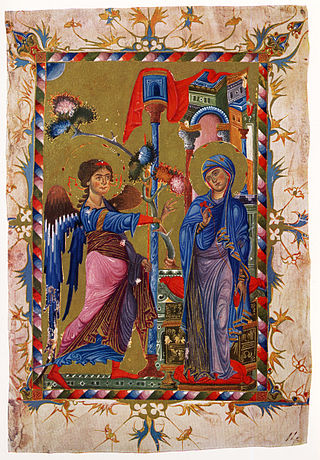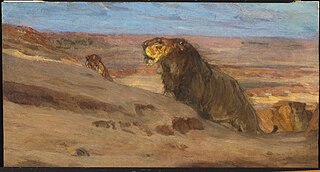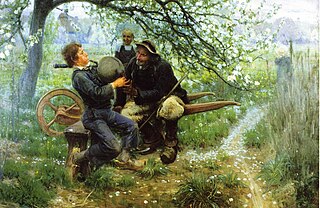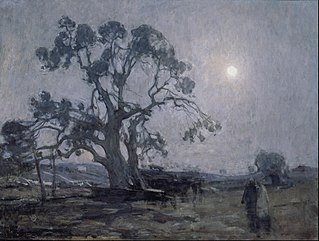
John Wanamaker was an American merchant and religious, civic and political figure, considered by some to be a proponent of advertising and a "pioneer in marketing". He served as United States Postmaster General in the Benjamin Harrison administration from 1889 to 1893.

The Annunciation is, according to the Gospel of Luke, the announcement made by the archangel Gabriel to Mary that she would conceive and bear a son through a virgin birth and become the mother of Jesus Christ, the Christian Messiah and Son of God, marking the Incarnation.

Henry Ossawa Tanner was an American artist who spent much of his career in France. He became the first African-American painter to gain international acclaim. Tanner moved to Paris, France, in 1891 to study at the Académie Julian and gained acclaim in French artistic circles. His painting Daniel in the Lions' Den was accepted into the 1896 Salon, the official art exhibition of the Académie des Beaux-Arts in Paris. Tanner's Resurrection of Lazarus was purchased by the French government after winning the third-place medal at the 1897 Salon. In 1923, the French government elected Tanner chevalier of the Legion of Honor.
The Annunciation is the biblical episode of the announcement by the archangel Gabriel to Mary that she would become the mother of Jesus.

The Annunciation has been one of the most frequent subjects of Christian art. Depictions of the Annunciation go back to early Christianity, with the Priscilla catacomb in Rome including the oldest known fresco of the Annunciation, dating to the 4th century.

Lions in the Desert is a painting by Henry Ossawa Tanner, painted in 1897–98 during a visit to the Middle East.

The Young Sabot Maker is an oil-on-canvas painting made by the American artist Henry Ossawa Tanner in 1895. The painting was accepted for the 1895 Paris Salon and was Tanner's second Salon-entered painting.

The Banjo Lesson is an 1893 oil painting by African-American artist Henry Ossawa Tanner. It depicts two African-Americans in a humble domestic setting: an old black man is teaching a young boy – possibly his grandson – to play the banjo.

Atherton M. Curtis was an American art collector and a writer from Brooklyn, New York City, who settled permanently in Paris, France, in 1903. He was also an author of introduction, art historian and publisher, who donated numerous archaeological items to the Louvre and other museums. He was also a principal benefactor of the Humane Society, and is recorded as being a strong supporter for the abolition of vivisection.

The Thankful Poor is an 1894 genre painting by the African-American painter Henry Ossawa Tanner. It depicts two African Americans praying at a table, and shares common themes with Tanner's other paintings from the 1890s including The Banjo Lesson (1893) and The Young Sabot Maker (1895). The work is based on photographs Tanner had taken, and is influenced by his views on education and race, which were in turn derived from those of his father, Benjamin Tucker Tanner, and the African Methodist Episcopal Church. The painting is considered a milestone in African-American art, notably for its countering of racial stereotypes.

The Bagpipe Lesson is a painting by Henry Ossawa Tanner, completed in late 1893 and displayed at the World's Columbian Exposition and at the Pennsylvania Academy of the Fine Arts 63rd annual exhibition, held from December 18, 1893 to February 24, 1894. The painting was begun by Tanner during his first summer in France, during a trip to Brittany. He finished the work in Philadelphia.

Sarah Elizabeth Tanner was active as a missionary worker and a religious leader in the African Methodist Episcopal Church.

Woman From the West Indies is a painting by Henry Ossawa Tanner painted about 1891 in Brittany, France, during his first or second summer in France. The portrait is unsigned but is attributed to Tanner based on the way it was painted, compared to Tanner's known works from 1891-1893. Those examining the painting looked for patterns in the way the artist used color, the brush strokes, and the stylistic choices in how light itself is shown in the painting.

Salomé is a painting by Henry Ossawa Tanner, showing the princess Salome from the Bible, who danced before her stepfather Herod Antipas, and who demanded the head of John the Baptist as a reward for her performance. Tanner painted Salome as part of his Christian-themed paintings.

Abraham's Oak is a painting by Henry Ossawa Tanner, an American painter who lived in France, completed about 1905. While Tanner is well known today for two paintings in the United States, The Banjo Lesson and The Thankful Poor, both about African-American families, the bulk of his artwork, including some of his most iconic paintings, were concerned with exploring biblical subjects. Abraham's Oak was supposed to be a place where Abraham pitched his tent and built an alter to God, who had promised the Land of Canaan for him and his children, and where he was visited by an angel.

Flight into Egypt was a painting by Henry Ossawa Tanner, created in Paris about 1899 and displayed at the Carnegie Institute that year, along with Judas. The painting, a religious work, is an example of Tanner's symbolist paintings. The 1899 version was his first version of the painting.

The Resurrection of Lazarus is a painting by Henry Ossawa Tanner entered into the Paris Salon in 1897 and winning a third place medal. During his lifetime, this was the painting for which he was most known, his "masterwork". Since his death in 1937, secular tastes have pushed The Banjo Lesson to the top place in public esteem. The work was purchased by the French government for display in its Luxemburg museum. Today the painting is held by the Musée d'Orsay.

Christ at the home of Mary and Martha is a painting by Henry Ossawa Tanner completed about 1905 and permanently in the collections of the Carnegie Museum of Art in Pittsburgh, Pennsylvania. Tanner spoke of the painting as having been particularly challenging to paint. The painting was purchased in 1907 by the museum. It was also exhibited in Pittsburgh in 1907 and New York in 1908.

Nicodemus Visiting Christ is a painting by Henry Ossawa Tanner, made in Jerusalem in 1899 during the artist's second visit to what was then Palestine. The painting is biblical, featuring Nicodemus talking privately to Christ in the evening, and is an example of Tanner's nocturnal light paintings, in which the world is shown in night light.



















